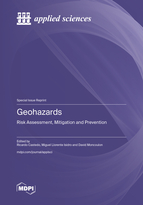Geohazards: Risk Assessment, Mitigation and Prevention
A special issue of Applied Sciences (ISSN 2076-3417). This special issue belongs to the section "Earth Sciences".
Deadline for manuscript submissions: closed (20 June 2023) | Viewed by 63699
Special Issue Editors
Interests: blast and impact engineering (structures and materials); numerical modelling; computational fluid dynamics
Special Issues, Collections and Topics in MDPI journals
Interests: landslides, floods, tsunamis, rock mechanics, natural hazards modelling; natural risks modelling; disaster prevention; management and mitigation of natural hazards
Special Issues, Collections and Topics in MDPI journals
Special Issue Information
Dear Colleagues,
This special issue aims to provide a common forum to share knowledge about the growing threat of Geohazards such as landslides and rock slides, earthquakes, floods, tsunamis, coastal erosion, drought among many others, due to the expanding size the cities and urban areas, critical use of agricultural lands, the increased use of infrastructure, and the effect of climate changes.
Original work related to the topic is welcomed, along with side topics if demonstrated to have a direct application into the theme, such as field surveys, numerical modelling, statistical analysis, monitoring, vulnerability and risk assessment, mitigation and adaptation strategies.
Dr. Ricardo Castedo
Dr. Miguel Llorente Isidro
Dr. David Moncoulon
Guest Editors
Manuscript Submission Information
Manuscripts should be submitted online at www.mdpi.com by registering and logging in to this website. Once you are registered, click here to go to the submission form. Manuscripts can be submitted until the deadline. All submissions that pass pre-check are peer-reviewed. Accepted papers will be published continuously in the journal (as soon as accepted) and will be listed together on the special issue website. Research articles, review articles as well as short communications are invited. For planned papers, a title and short abstract (about 100 words) can be sent to the Editorial Office for announcement on this website.
Submitted manuscripts should not have been published previously, nor be under consideration for publication elsewhere (except conference proceedings papers). All manuscripts are thoroughly refereed through a single-blind peer-review process. A guide for authors and other relevant information for submission of manuscripts is available on the Instructions for Authors page. Applied Sciences is an international peer-reviewed open access semimonthly journal published by MDPI.
Please visit the Instructions for Authors page before submitting a manuscript. The Article Processing Charge (APC) for publication in this open access journal is 2400 CHF (Swiss Francs). Submitted papers should be well formatted and use good English. Authors may use MDPI's English editing service prior to publication or during author revisions.
Keywords
- landslides and rock slides
- earthquakes
- floods
- tsunamis
- coastal erosion
- numerical modelling
- risk assessment
- hazards
- mitigation
- prevention








